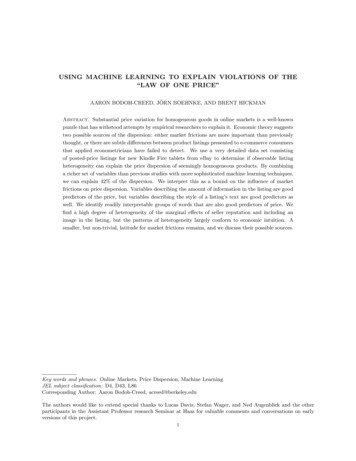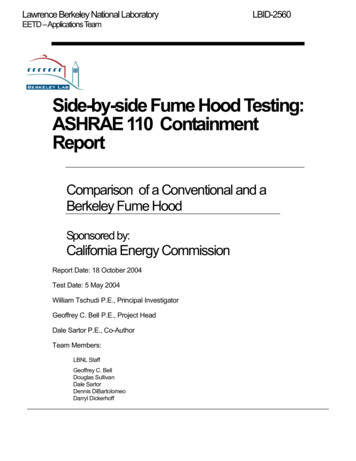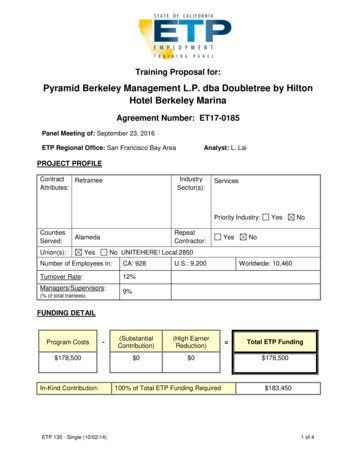
Transcription
USING MACHINE LEARNING TO EXPLAIN VIOLATIONS OF THE“LAW OF ONE PRICE”AARON BODOH-CREED, JÖRN BOEHNKE, AND BRENT HICKMANAbstract. Substantial price variation for homogeneous goods in online markets is a well-knownpuzzle that has withstood attempts by empirical researchers to explain it. Economic theory suggeststwo possible sources of the dispersion: either market frictions are more important than previouslythought, or there are subtle differences between product listings presented to e-commerce consumersthat applied econometricians have failed to detect. We use a very detailed data set consistingof posted-price listings for new Kindle Fire tablets from eBay to determine if observable listingheterogeneity can explain the price dispersion of seemingly homogeneous products. By combininga richer set of variables than previous studies with more sophisticated machine learning techniques,we can explain 42% of the dispersion. We interpret this as a bound on the influence of marketfrictions on price dispersion. Variables describing the amount of information in the listing are goodpredictors of the price, but variables describing the style of a listing’s text are good predictors aswell. We identify readily interpretable groups of words that are also good predictors of price. Wefind a high degree of heterogeneity of the marginal effects of seller reputation and including animage in the listing, but the patterns of heterogeneity largely conform to economic intuition. Asmaller, but non-trivial, latitude for market frictions remains, and we discuss their possible sources.Key words and phrases. Online Markets, Price Dispersion, Machine LearningJEL subject classification: D4, D43, L86Corresponding Author: Aaron Bodoh-Creed, acreed@berkeley.edu.The authors would like to extend special thanks to Lucas Davis, Stefan Wager, and Ned Augenblick and the otherparticipants in the Assistant Professor research Seminar at Haas for valuable comments and conversations on earlyversions of this project.1
2AARON BODOH-CREED, JÖRN BOEHNKE, AND BRENT HICKMAN1. IntroductionThe “Law of One Price” (LOP) predicts that all exchanges of homogeneous goods in a thick,frictionless market ought to take place at a single price. While the LOP holds remarkably well insome instances (e.g., security exchanges), in most consumer product markets it fails to describereality. This fact is pithily summarized by Hal Varian, who wrote “the law of one price is no lawat all” (Varian [37]).One might expect the LOP to hold more often in online markets due to heavy participationby buyers and sellers, and because of modern database and user-interface technology that wouldseem to make product search as frictionless as possible. To the contrary, however, non-trivial pricedispersion online is a well documented fact, even for products that appear homogeneous, such asnew books (e.g., Bailey [3], Brynjolfsson and Smith [12]). In a model with rational buyers andsellers, price variation for seemingly homogeneous products can arise from three sources. First, itcould be that units of a given product are actually heterogeneous in subtle ways that are apparentto consumers, but difficult for the econometrician to detect in the data. Second, it could be thatsellers offer complementary services that buyers value (e.g., a warranty). Third, market frictions(e.g., search costs or informational asymmetries) combined with strategic competition betweensellers could endogenously generate equilibrium price dispersion for homogeneous products.The source of price dispersion has important implications for platform design. If the underlyingproducts are subtly heterogeneous, or if sellers differentiate their product offerings by bundlingthem with extra goods or services, then a consumer’s search problem is harder than one might haveinitially conjectured. Either scenario might in turn imply that sellers operate in an environment of(constrained) monopolistic competition with distorted allocations and dead-weight loss from rentseeking behavior. On the other hand, if price dispersion is due solely to information frictions, thenimproved search algorithms may alleviate the problem. Either way, platform designers can playan important role in effectively matching consumers and products if the sources of price dispersioncan be discovered.Few settings would appear to more closely resemble the canonical marketplace of perfect competition than eBay’s posted-price market for new, first-generation Amazon Kindle Fire tablets, whichwe refer to simply as “Kindles.” It is quite thick, with thousands of buyers and sellers interactingregularly. Although search costs are a well known source of price dispersion in the theoretical literature (e.g., MacMinn [27], Reinganum [31], Burdett and Judd [13]), eBay’s web-based, interactivesearch utility would seem, at first glance, to make it easy to obtain a price quote. Another classof models that generates price dispersion considers situations where firms interact with two classesof customers that are asymmetrically informed: loyal or unsophisticated consumers that obtain asingle price quote and others that obtain multiple price quotes. These models do not provide arealistic description of eBay, with its many participants connected by a common online forum, sincethey assume sellers have a captive market of buyers that are either uninformed about the pricesof competitors (e.g., Salop and Stiglitz [34], Rosenthal [32], Wilde and Schwartz [39], Varian [37])or are loyal customers of the firm (Baye and Morgan [5]). Finally, many of the obvious sources
EXPLAINING VIOLATIONS OF THE “LAW OF ONE PRICE”3of product heterogeneity are ruled out in our setting. For example, bundling of new Kindles withaccessories is rare in the data, and when present the accessories are of low value. Seller reliabilitymight induce significant price heterogeneity, but eBay’s strong warranty against seller misbehaviorshould eliminate this as a first-order concern for buyers. These features suggest that consumersought to view the various seller listings as near-perfect substitutes. Yet, we find that the standarddeviation of price for new Kindles on eBay is nontrivial, at 21.2% of the mean price.1In order to shed light on this puzzle, we execute an empirical analysis of a unique and very detailed dataset on a thick marketplace for seemingly homogeneous goods. Once again, the two mostplausible explanations offered by economic theory are that either subtle differences exist acrosslistings which consumers can detect, or that search frictions are non-trivial after all, giving rise tonon-degenerate price distributions in equilibrium. If observable product heterogeneity can explainprice dispersion, then in principle it should be possible to identify features of online product listingsthat predict differences in prices across listings. Our first goal in this project is to extract moredetailed product listing covariates and to implement more sophisticated methodologies—machinelearning—than previous studies, in order to detect whether observable product listing characteristics have predictive power for price differences. These two contributions are meant to solve twoprincipal problems, ommitted variable bias and functional form mis-specification, which may haveartificially limited price prediction power in previous empirical studies. Although our empiricalmodel is predictive in nature, for our purposes we need not identify a causal demand system inorder to parse between models which account for price dispersion. Rather, since the various searchfriction models imply pricing noise which is plausibly orthogonal to observable characteristics, anypredictive power to be found necessarily places a bound on the role that search frictions could play.Our second goal is to use economic theory to interpret the results of our empirical analysis inorder to explain why observable listing features create heterogeneity. We also use machine learningtechniques to detect heterogeneity in the marginal effects of product listing characteristics (e.g.,the impact on expected price of including an image in the listing). Since these marginal effectscan be naturally interpreted in terms of seller incentives, we also explore whether the results of ouranalysis align with economic theory.To facilitate our empirical analysis of the possible roles for listing heterogeneity and searchfrictions in explaining price dispersion, we have assembled a very detailed dataset. Our raw dataconsist of downloaded .html pages for thousands of listings for new Kindles on eBay. These pagesallow us to see virtually all information displayed to the consumer by eBay’s interactive web portal.Individual listing pages provide a wealth of information offered to the user, including potentialsubtle queues that may nudge the price up or down by perceived differences in value. The firstportion of each listing’s webpage includes the seller-supplied title and photos of the product, the1One possible concern is that perhaps many eBay sellers incorrectly list used items as “new.” In this paper we studya detailed dataset on Kindle listings, in which this does not appear to be a meaningful problem. A manual inspectionof 200 listings revealed 78 listings that explicitly mentioned that the item was factory sealed, three listings suggestingthe box had been opened, and the remaining listings either had no seller customized description or did not explicitlyrepeat the definition of a “new” item beyond what eBay provides as a standard description for new Kindles. Wefound no examples of items with significant usage prior to listing the item for sale.
4AARON BODOH-CREED, JÖRN BOEHNKE, AND BRENT HICKMANprice and shipping cost, and a measure of the seller’s reputation computed by eBay. The secondsection is a standardized description of the product, provided by eBay, that concisely spells outthe technical features of the Amazon Kindle, as well as eBay’s definition of a “new product.” Thethird section of each listing displays additional, customizable information provided by the seller,including additional photos and/or formatted textual descriptions.The information contained in the first and third sections is almost entirely at each seller’s discretion, and is therefore fairly complex and variable across different listings. Because we havecaptured the original .html content used by eBay to format and display each product page to theuser, we are able to analyze almost everything that potential buyers see. We captured all textinformation the seller optionally provided about the product, as well as the number, size(s), andtype (stock or non-stock) of the photos the seller posted in his or her listing. We find that the itemdescription provided by the sellers varies widely from listing to listing. For example, the listingshad an average of 4.09 photos with a standard deviation of 4.39. Listings also had an average of131 words of text written by the seller, but the standard deviation of the number of words is 280,and 16% of listings include no seller-provided description at all. We also parse the content of thetext using a bag-of-words approach, leaving us with a total of 220 regressors that characterize eachof the 1298 Kindle listings in our data set.Our first empirical goal is to assess the amount of price variation we can explain by applying thesehigh-dimensional observables and machine learning techniques to the task. The existing literaturehas made little headway in explaining online price variation, but we investigate whether this isbecause previous studies have ignored some information observed by the user (e.g., our text andimage variables), inducing an omitted variable bias, or whether the cues that consumers extractfrom these data manifest themselves in complex and subtle ways that are masked by restrictivefunctional forms used in previous studies (e.g., ordinary least squares versus sophisticated machinelearning models), or both. To address this question, we first construct a restricted data set usingonly regressors comparable to those employed in the prior literature on price dispersion. We measurethe independent importance of our richer data set by comparing the explanatory power of a givenmodel estimated on the restricted data to the explanatory power of the same model estimated onthe full dataset. The importance of the model employed is assessed by comparing the predictivepower of the two models estimated on the same data set. We can explain 12% of the price variationusing an ordinary least squares (OLS) model and our basic data set, which is in line with the weakpredictive power observed in the previous literature.2 An OLS model estimated on our full set ofvariables explains 15% of the price variation, meaning the rich set of regressors alone improves thepredictive power of OLS, but only slightly.2See Section 2 for a brief discussion. This comparison with the previous literature is not intended as a model selectionexercise for many reasons (e.g., the differing data sets). Rather, we wish to make the simpler point that the vastmajority of observed price variation remains unexplained if one relies on OLS techniques and basic observables, as inthe prior literature.
EXPLAINING VIOLATIONS OF THE “LAW OF ONE PRICE”5We then examine the predictive power of an alternative model based on a regression forest(Breiman [11]).3 Much like a k-nearest neighbor or a kernel-smoothed regression, a regressionforest uses observations that are near the point of interest to generate a localized prediction. Asingle regression tree uses a data-driven algorithm to partition the space of regressor values todefine what “near the point of interest” means. Then one level up, a regression forest averagesthe predictions of an ensemble of regression trees to make a prediction. Regression forests haveproven popular due to their ability to capture complex interactions between large sets of regressorsin a principled way that allows for relatively little subjective input from the analyst regardingmodel selection. When we apply our regression forest techniques to the basic data set, we canexplain 19% of price variation, and when we combine this approach with the full data set, ourexplanatory power increases to roughly 42% of the price dispersion. The explained price variationis economically significant at over 10% of the mean price of a new Kindle. In short, both highdimensional observables and sophisticated machine learning techniques are required in tandem toadequately capture the complex process of information transmission between buyers and sellersthat leads to explainable price dispersion.4One possible criticism of our OLS approach is that we may have handicapped standard linearmodels for the comparison by estimating an insufficiently flexible model. To explore this possibility,we build a dataset that includes a complete set of first-, second-, and third-order interactions of ourfull set of regressors, which results in a model with 6,463 variables. After using LASSO to chooseour regressors, we find that the linear model still explains only 23% of the variation in prices. Ourconclusion is that, while a more flexible linear model can (unsurprisingly) predict a greater degreeof price variation than low-dimensional OLS, the model would have to be impractically flexible tobegin to approach the capabilities of machine learning methods.One common drawback of machine learning is that with its impressive flexibility comes greaterdifficulty in interpreting results. In order to better understand the sources of the predictive powerwe uncovered, we partition our variables into intuitive subsets that are likely to measure the amountof information conveyed (e.g., the volume of text and number of images) and variables that representthe style of the listing (e.g., text style and formatting). In order to pin down which combinationsof variables are providing the predictive power, we analyze the effect of adding different groupsof variables to our basic data set and deleting different sets of variables from our full data set.Since sellers have an incentive to accurately describe the product for reputational reasons, it is easyto come up with an information-based explanation for how the volume of information predicts ahigher or lower price (e.g., explaining a defect in the packaging). We find that we lose only a smallamount of predictive power by estimating our model on only the basic data set plus the variablesthat summarize the volume of information conveyed.3We also experimented with other methodologies such as neural networks and boosted gradient trees, but we foundthese more complex techniques performed no better than a regression forest.4As a robustness check for external validity of our results, we repeat our prediction exercise for another consumerelectronic product: Microsoft Surface tablets, a much more expensive item that can serve as a laptop replacement,rather than just a simple electronic media device. We find very similar results; we can explain 43% of the pricevariation among Surface tablets using high-dimensional observables in combination with machine learning techniques.
6AARON BODOH-CREED, JÖRN BOEHNKE, AND BRENT HICKMANWe also find that the style variables have as much explanatory power as the variables describingthe volume of the information conveyed by the listing. It is more difficult to provide an explanation grounded in economic theory for why the style of the listing would influence the offeredprice. For example, one might conjecture that the style variables signal a seller’s professionalismand/or reliability in a way more familiar and interpretable to the user than the eBay reputationscore. Alternatively, from the perspective of consumer psychology it could be that buyers have anemotional response to the aesthetic of the listings, and this in turn affects willingness to pay.Finally, we use honest model trees, first developed in Athey, Tibshirani, and Wager [1], to studypossible heterogeneity of the marginal effects of listing features on predicted price. We find thatthere is a high degree of heterogeneity in the marginal effects across listings in our sample. Forexample, the marginal effect of including an image ranges from near 0 to about 20. Sellersgenerally appear to efficiently use the information at their disposal, and we find that the marginaleffect of including an image in the description is significantly smaller for those sellers that do not,relative to those sellers that do (as economic theory would predict).Our analysis shows that there is a significant degree of product listing heterogeneity, even inthe market for new electronics products, and detecting the heterogeneity requires a rich data setand flexible estimation techniques. Contrary to the quote from Varian [37] above, the law of oneprice may be a law—just a fairly vacuous one. The sources of the product heterogeneity alignwith economic intuition: variables related to the informativeness of a listing provide a great dealof our predictive power. Surprisingly, variables describing the style of the listing also predictthe price dispersion well. Finally, the marginal effects of our regressors display a high degree ofheterogeneity, but this heterogeneity tends to align with our economic intuitions concerning profitmaximization by sellers. At the end of the day, however, we also find that, despite extremelydetailed observables being combined in very complex ways, significant unexplained price variationpersists, suggesting that search frictions may also play an economically meaningful role. This mayseem counter to expectations, given cutting edge search algorithms at eBay users’ disposal, butone possible explanation is an “embarrassment of riches” problem. Given the sheer scope of themarketplace, it may be that there are so many relevant results for a keyword search on the phrase“Amazon Kindle Fire” that it is still costly for consumers to sift through all of them.The remainder of this paper has the following structure. We start with a discussion of the relatedliterature in Section 2. Section 3 provides a description of the mechanics of the eBay posted-pricemarket place and describes the listings that we study. Section 4 describes the data we collected.Sections 5 presents basic results on the importance of (i) the richness of our data set and (ii)flexible estimation techniques for predicting the price associated with a listing. Section 6 exploresthe underlying structure of the data that is captured by our regression forest models. Section 7provides robustness checks, and we conclude in Section 8.2. Related LiteraturePrice dispersion as a consequence of ignorance has been recognized at least since Stigler [36].Building on Stigler’s original model of costly search, Diamond [17] proved that profit maximizing
EXPLAINING VIOLATIONS OF THE “LAW OF ONE PRICE”7firms can act as monopolists if consumers face search costs. Although the model of Diamond [17]does not yield equilibrium price dispersion, it does show that large deviations from the perfectlycompetitive outcome are possible if consumers face small search costs. Reinganum [31] shows thatprice dispersion can arise when consumers discover prices through a process of sequential searchand firms have heterogeneous marginal costs. MacMinn [27] shows that price dispersion can alsoarise under this market structure when fixed-sample search is used.A second potential source of price dispersion is information asymmetries amongst consumers.These models assume that firms are homogenous, but buyers are asymmetrically informed eitherbecause of heterogeneous buyer search costs (e.g., Salop and Stiglitz [34], Rosenthal [32], Wildeand Schwartz [39], Varian [37]) or because of heterogeneous outcomes of a stochastic search process(e.g., Burdett and Judd [13]). The firms respond to the asymmetrically informed consumers byplaying a mixed strategy wherein the firms randomize over their prices, which generates equilibriumprice dispersion despite the homogeneity of the firms and the products. The more recent literaturehas applied models of this form to study online price clearinghouses as important strategic actorsin the affected markets (e.g., Baye and Morgan [5], Baye et al. [8]).A large branch of the more recent empirical literature on price dispersion has focused on tests ofvarious models. For example, Sorenson [35] shows that pharmaceutical products that necessitaterepeated purchases have lower price variation since the consumers have a strong incentive to finda low price. Baye, Morgan, and Scholten [6] and [7] use data from a price comparison web siteand data on the market structure across different products to test the implications of informationclearinghouse models. Baylis and Perloff [10] find a combination of high-quality, low-priced firmscompeting with low-quality, high-priced firms in the online markets for scanners and digital cameras,which the authors interpret as support for the two-price equilibrium predicted by Salop and Stiglitz[34]. Some papers estimate a structural model to tease apart the sources of price variation basedon the estimates (e.g., Hong and Shum [25]).The focus of our paper is identifying features of the listings that predict price dispersion. Thereare prior studies that attempt to predict product prices and report statistics that describe theirexplanatory power, but many of the estimates have features that make them difficult to comparewith our results. Among the papers that are comparable to our project, Baye, Morgan, andScholten [9] attempts to predict the price dispersion for online consumer electronics sales. Theirprice regression can explain 17% of variation using regressors capturing the attributes of the retailers, but the explanatory power jumps to 72% when the regressions include firm-specific dummyvariables. Clay, Krishnan, and Wolfe [16] provides an analysis of the price dispersion of text booksthat explains 2.7% of the dispersion when regressions do not include store-level dummy variablesand 19.2% of the dispersion when the dummy variables are included. Pan, Ratchford, and Shankar[29] study the price dispersion across eight categories of retail products and can explain at most22% of the price dispersion, with the notable exception being that their regressions explain 43% of
8AARON BODOH-CREED, JÖRN BOEHNKE, AND BRENT HICKMANprice variation for compact discs. Our general conclusion from the empirical literature is that pricedispersion is difficult to explain without including regressors such as seller-specific fixed effects.5Even when seller dummy variables can explain a great deal of the price variation, it is unclearwhat exactly the dummy variables are capturing. For example, suppose that one concludes thatBest Buy, a brick and mortar electronics retailer in the United States that also has an online store,has consistently higher prices than other electronics retailers. The higher prices at Best Buy couldbe because the products are different (source one: product heterogeneity), it could be that Best Buyoffers generous return policies (source two: heterogeneous retailers), or that Best Buy has a nearmonopoly over brick and mortar electronics sales in many regions that allows the firm to chargehigher prices (source three: market competition). In other words, including dummy variables forindividual sellers does not shine much light on the underlying cause of the price variation.Dinerstein et al. [18] directly examines a redesign of the eBay platform meant to encouragebuyers to consider low-priced products and enhance price competition amongst sellers. Prior toMay 19, 2011, eBay showed buyers that searched for a product a list of “Best Match” results thatdid not explicitly consider price when ordering the products displayed to the user. From May 2011through the summer of 2012 eBay allowed users to designate the specific product they wished tosearch for, and the platform displayed the posted-price listings in order of increasing total price.Starting in late 2012 (prior to our data collection period), eBay returned to using the “Best Match”as the default. Dinerstein et al. [18] estimate a model of consumer demand using detailed data onbuyer behavior on the eBay platform. The authors assume that users consider a random number oflistings that are randomly selected based on either the listing’s quality during the pre-experimentalperiod or the price under the redesigned platform.6 They show that when the platform emphasizeslow prices when generating the list of search results for buyers, then price dispersion decreases.We would also like to highlight a handful of other papers that have worked directly with eBay“Buy It Now” data. For example, Hui et al. [26] studies the interactions between the effects ofreputational mechanisms and insurance against seller misbehavior on the prices received by sellersin Buy It Now and auction listings on eBay. Saeedi and Sundaresan [33] study a sample of Buy ItNow and auction listings on eBay to understand the effect of a change in the reputation system onbuyer and seller behavior. Other papers have studied the relationship between Buy It Now postingsand auctions with a particular focus on the economic forces that allow the two sales mechanismsto coexist on the same platform (e.g., Einav et al. [19], Einav et al. [20], Einav et al. [21]). Noskoand Tadelis [28] documents that buyers’ experiences with sellers spills over onto other sellers, andthe authors propose a novel and more effective metric of interaction quality. Elfenbein, Fisman,and McManus [22] study the interaction of the value of quality certification and market structure.To the best of our knowledge, we are the first to use data from a platform like eBay to study price5Clay, Krishnan, and Wolfe [15] attempts to predict prices and achieves a high degree of explanatory power, but theirregressions include time dummies. Time dummies explain a great deal of the price variation across our sample dueto product depreciation, but this price variation is unrelated to the day-to-day, cross-sectional price dispersion weare interested in. This makes it impossible to compare the explanatory power of these regressions with our analysis.6The authors base their estimates on users’ browsing behavior, but they implicitly assume that this browsing behavioris largely driven by platform design.
EXPLAINING VIOLATIONS OF THE “LAW OF ONE PRICE”9dispersion, utilize contextual data (e.g., text or images) as rich as ours, or bring machine learningtechniques to bear to explain price dispersion.3. The eBay SettingeBay uses a fine-grained, hierarchical product classification system for the goods listed for sale onthe platform. For example, all Kindles are in the “Tablets & eBook Readers” category, but therealso exists a separate category at the bottom of the hierarchy for new, first-generation AmazonKindle fire tablets with 8 GB of storage. The product classification system encourages productheterogeneity within broad product categories (e.g., tablet computers) and very limited productheterogeneity at the narrowest level of classification.Although eBay initially served as a platform for sellers to use auctions to sell items, more thanhalf of the items available for sale on eBay are now sold using a posted-price format referred to asa “Buy It Now” listing. A seller using a posted-price format has the option to provide title textand a photo that will appear in the page of search results observed by prospective buyers. Forconsumer electronics products, the seller must also provide the exact specifications (e.g., 8 GB ofstorage) and condition (e.g., New) of the product so that it can be placed within the eBay producthierarchy. The price of the product as well as the shipping options must also be chosen. The sellercan either offer flat-rate shipping or choose to have shipping calculated by eBay. If t
they assume sellers have a captive market of buyers that are either uninformed about the prices of competitors (e.g., Salop and Stiglitz [34], Rosenthal [32], Wilde and Schwartz [39], Varian [37]) . EXPLAINING VIOLATIONS OF THE \LAW OF ONE PRICE" 3 of product heterogeneity are ruled out in our setting. For example, bundling of new Kindles .











